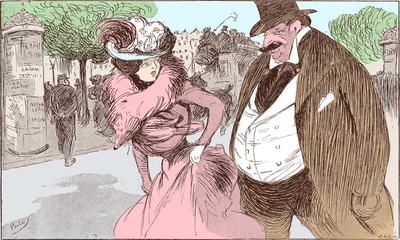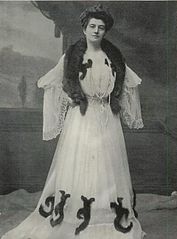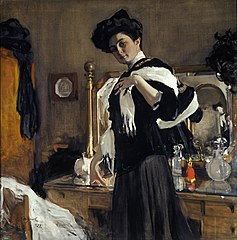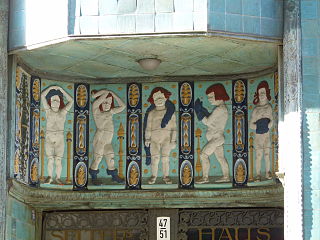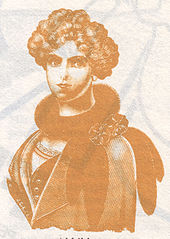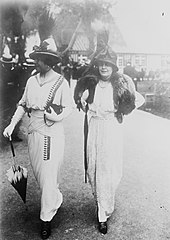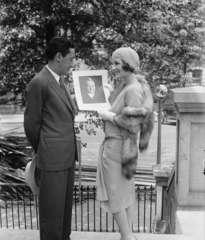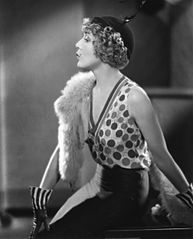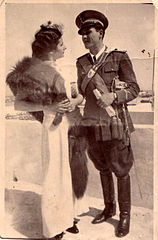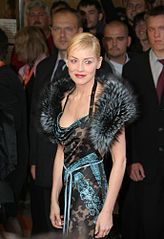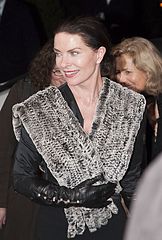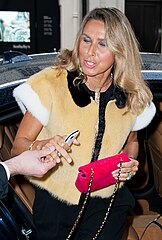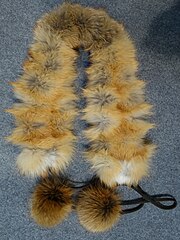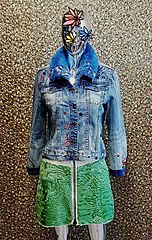Summer fur (fashion)
As summer fur is in fashion in the summer to wear clothing made of fur called. At times, summer fur made up a significant part of the fur industry's turnover during the so-called “quiet”, “quiet” or “dead time”. In zoology, on the other hand, summer fur is understood to mean the less dense fur of the fur-bearing animals after a coat change in spring.
In addition, there are regional furs , mostly associated with traditional costumes , which are worn all year round, such as the sporran , the men's bag with the Scottish kilt or the red fox tail on the hat of the fox major of some German student associations.
Main types of summer fur, clothing and accessories
Naturally, particularly light and short-haired types of fur are suitable for summery fur clothing . In addition, long-haired skins, preferably as small fur scarves, collars and trimmings, in light colors, are worn on a large scale in summer, mostly made of fox fur . In haute couture , evening wear was at times dominated by the most valuable types of fur, "even in summer".
In the first wave of summer furs at the beginning of the 20th century, the furs that are common for luxury goods, such as pecan skins and wallaby skins, were so overpriced by the “Russian fur aristocrats” that they were not considered for German summer skinning. Instead, they turned to other fur suitable for the summer. “As a result of the artistic processing”, refined rabbit fur , marten and mole sold well. A sudden preference for patterned furs and inlaid effects stimulated sales of white-forked skunks , civets , and leopards [ Leopard cats? ] and above all “delightful ermine seal or white fox and lynx arrangements ”.
In 1914 it was said about the various fur accessories:
"If you check the individual furrier's works of art on the owners themselves, everything that is imaginable is actually worn in terms of cut, size, color and workmanship. Bonnets, shoulder collars , fur ties , trimmings and coquettish mink stripes to emphasize the front line were seen and aroused enthusiasm. Obvious reluctance, on the other hand, was first met by the now finally invented summer muff . When this seemingly absurdity revealed its comfortable interior design, it replaced all the trailer bags within a few days, which are rarely practical and even less often look good. Tulle embroidery gives the fragrant, light, very flat structure its body. Stripes of ermine from dazzling Weisse or Silberfuchs , also Kolinsky and German polecat , make it a furrier's work of art in the first place. "
In the second epoch of summer fur from 1916 onwards, fur types that had received little or no attention were suddenly particularly in demand. In the case of the small and therefore above all light, thin-leather and short-haired pelts, these were, among other things, the skins of the Burunduki , the mole and the peschaniki, which are persecuted as agricultural pests . In 1927, gazelle skins were sheared and dyed for summer furs in fashion colors, skins that until then had only been a problem because of their short shelf life. Probably in the justified view that they would not be as stressed as winter fur. The equally sensitive lilac-brown antelope fur , made into coats in Paris, now attracted attention. The Berlin journalist Adolf Stein noticed, also in 1916, at a fashion tea in the large old garden of the resource in the Oranienburger Strasse under the “delicious light summer fur” especially those made of “blonde” mole, as well as “royal” ermine, and as a substitute white Chinese rabbit, sable , kid , broadtail , gazelle and fox, including a lot of dyed and sheared items.
At the end of the 20th century, furs made from braided thin strips of fur came into fashion as a novelty. Partly only as loose fur grids, they are particularly suitable as summer accessories. Since then, scarves, capes, vests and ponchos have been seen in large numbers in cities, at least in spring and autumn. Most of the parts made in Asia are made from rabbit fur , and quite often from mink fur.
Mink Bag / Keychain
( Fendi 2010)Mink Boa, Liesl Karlstadt (1955)
Chinchilla scarf and cap, Gila Golan (1966)
Little fox cape, Zhang Ziyi (2013)
Ankle boots ( Michael Kors , 2014)
history
The use of fur in summer Central Europe or other countries with a similar climate is largely unexpected. Quintus Aninius wrote about the legendary inhabitants of the island of Thule in 1336 : “In winter they wore silk clothes and in summer furs. Their wise men locked them in cages, and their fools let go. The Thulensians were foolish people. "
1898 to 1914, the first year of the First World War
The wearing of modern summer fur has so far been reserved for women. In 1913, before the First World War, the furrier Hans Werner from Gera emphasized that the “no less rapid than successful introduction of summer fur in Germany is due to the elegant French women who spend the high season on our North Sea. Parisian furrier art in the processing of summer smoke and the proverbial mastery of toilette-knowledgeable daughters of the French capital of fashion - can the fur man wish for more powerful allies? ”For some years,“ influential companies ”tried the summer fur with the help of fashion against what had become common for ten years July and August cold to enforce. It has long been normal that the entire “fur state” was taken with them during the summer vacation. “At the sea, as in the mountains”, “you could see furrier's art in the most modern models and buy it in newly opened branches of major houses in the industry”.
Fur trimmings and fur accessories were worn in all seasons. Since 1918, the Parisian fashion designer Paul Poiret , who was inspired by the ballets of the Russian Djagilev , played a major role in this . An English publication from the period stated: “The dark, abundant addition of fur is part of practically every description of a coat and, in fact, with every clothing - even on nightgowns and pajamas. [...] Everything is covered with fur, from our hats and handbags to lingerie. Many of the latest crepe-de-chine ' underwear ' are edged with fur ”. - Daisy, Countess of Warwick, appeared at an English garden party in 1912 in a summer dress, with a large muff made of paper-thin material, trimmed with roses and ribbons made of fur.
Ermine jacket ( Revillon Frères , 1903, Metropolitan Museum of Art)
Sable scarf and cuffs ( Redfern , 1904)
Fur scarf and ermine muff ( Armand & Martial , 1905)
Fur necklace made of twisted tails with rosettes (1911)
Silver fox necklace in Trouville (1913)
1926 to 1939, beginning of the Second World War
Apparently these successes and the summer furs were already forgotten after the war. The reason for again enforcing the wearing of suitably light furs also in summer was above all the economic hardship of the Austrian and German furriers after the First World War and the subsequent German inflation until the mid-1920s. Vienna was already known as a city of elegant fashion during the imperial era and the Viennese wore particularly opulent fur clothing until long after the Second World War. The Viennese furrier Alexander Tuma jun. attributed the major success of the summer fur campaign in 1926 to his father: “Here and there his idea met with enthusiastic echoes. In the circles of the celebrities, however, one was more than skeptical; one even laughed at this phantasmagoria. It was claimed that fashion could not be 'made', that it could only come 'outside' at all. However, his father persevered, consistently publishing articles in the trade magazines and calling for participation in promotions at trade meetings. The cooperative of the Kürschner Vienna finally decided unanimously to increase the levies to finance the advertising costs. This was followed by articles with images in all the daily newspapers, posters on trams, fashion demonstrations, 'a propaganda campaign by women from the furrier industry with summer furs through the streets of Vienna', a corresponding design of the shop windows and much more. The foreign press also took up the topic 'and in a very short time the summer fur had prevailed'. The fashion studios, who created their own summer fur models, made a significant contribution to the acceptance of the new fashion. "
Tuma jun. reported further:
“The silver fox, neck bulls made of marten, mink, polecat and other furs were worn as well as capes, light jackets and paletots . Large fashion shows on the Viennese trotting course during the breaks, with summer furs being raffled off to the public and given free of charge, supported the propaganda powerfully. [...] No expense was spared; they bore a thousandfold interest. Whatever may come, how the economic situation may be, one must never give up on oneself. The best ideas are usually born out of necessity, but then you need a serious, great will and iron energy to put them into practice. "
In 1926, in the Viennese trade journal of Alexander Tuma, it was stated once again that the “summer fur hype” had surprised everyone; it was as if the audience had “just been waiting for the summer fur”. It was now being considered how this success could be carried over to winter with minimal costs. It was suggested that a “fur queen” should be chosen among the fur wearers themselves: “In this way we create good, general and cheap advertising, we secure the greatest interest in our articles for autumn and winter and at the same time preserve them Possibility of choosing a 'queen of summer fur' for the coming summer, which means that we can present summer fur as a fashion favorite in a completely natural and unobtrusive way. - Estimate: five thousand shillings ”.
As in Vienna, in 1926 the women of the furriers were also used as advertising media for summer fur in Berlin. A meeting was held in the garden of the Kroll establishment and the wives were obliged to wear fur. Almost 6,000 people came to a fashion show as part of the “Alpine Summer Show” organized by the Berlin Trade Fair Office in the Haus der Funkindustrie. In other German countries, similar actions were held by the local professional associations.
As early as 1927, the German fur manufacturers had especially adjusted to the manufacture of summer furs. In Berlin they are now claiming the enforcement of the term “summer furs”: “We do not want to forget that this word, coined by Berlin last year, has now found its way all over the world. While this term was hardly known in the past, it is now a catchphrase, and in the capital cities it will already have the greatest importance in this year. The summery fur coat is a loyal companion of the elegant woman. "
The Leipzig tobacco wholesaler Arthur Hermsdorf confirmed at the beginning of the thirties that the summer fur had penetrated so far by “running a few heads” that its right to exist could be considered proven and that one now had two fur seasons. He also noticed that fur became a fashion item at the same time and was no longer, as it was before, “the first main property of lasting value, an acquisition for life”. It was also thanks to summer fur that the “fantasy colors” made possible by innovations in the chemical industry prevailed for furs, colors that follow the textile fashion trends. As recently as 1903, a Leipzig leather dyeing author could not imagine dyeing furs other than natural-looking colors: “If you wanted to lecture radically, you simply wanted to impose a view that only needs to be illuminated in order to be applauded, then you can open up the fact that proves superfluous that it is indeed possible for fashion to match sky-blue handbags made of sky-blue leather with other, same-colored travel utensils made of luxury leather, but that it could now and never come to a tasteful lady, one to this gentle one Nuance to wish matching fur boa. The necessary justification for this self-explanatory impossibility is too obvious and simply follows from the fact that every useful or decorative fur is either real, i.e. entirely natural colored, or imitated, i.e. colored according to the model of the real one, if its wearer does not intend a masquerade . "
In 1926, Adolf Stein recalled that before the war there was hardly any spoiled English woman who wore fur that did not bear the “Leipzig color” brand; and stated, “The Berlin fur dyeing factory, colors from Citroen , has a worldwide reputation today. […] But fur in general is one of the most indispensable things for women today, even in summer. The higher up she shows only the thinnest pile on her silk legs , the more she needs warmth to spread from her shoulders. And only when the admiring male looks warm up even more can she let the fur slide down. "
In a dissertation on the “development tendencies of the fur industry” from 1930, the author stated that fur had lost its character as a seasonal item: “Today, fur has become the fashion of every season. This detachment of fur fashion from winter has increased demand, as has the advance of European fashion into those parts of the world that have so far remained true to the old national costumes ”. About the 1930s, Italian fashion writer Anna Municchi wrote that a lady who was enamored by the then most-watched films of the time, The Blue Angel , City Lights and Queen Christine , was no stranger to using fur in the warmest season. She began by preferring the soft ermine, as short boleros like those designed by Edward Molyneux or Lucien Lelong , either shorter at the front or draped around the shoulders. In 1933, one summer long-haired, shiny monkey fur was suddenly in fashion , also for a short time leopard fur . There was ermine again, this time in the summery biscuit color. All possible types of fur were tried out, and mink became increasingly important in the field of summer fur.
At the same time, fox fur was everywhere in fashion, as a coat, long cape, jacket or, suitable for spring, autumn and summer, as a small cape, trimmings, boas or quite a lot as trimmings of such clothing. Anna Municchi: “In the big fashion houses there were foxes that were miles long: He draped dresses and coats in a spiral, framed the shoulders in a double ring, attached or loose cuffs, occupied like a question mark, rimmed sleeves and finished off vests. It was worn round and held with a ribbon, somewhat asymmetrical, it framed the face, almost touching the curls and the little felt hat. All tailors, without exception, used it extensively. ”Another Italian fashion writer, Irene Brin, recalled:“ It was only a few years ago in 1932 that people started wearing light-colored foxes, which in the springtime became the traditional mole stoles , the Baummarderkolliers or ties from marten replaced: and now everyone wants to have two whole foxes with noses together and tied paws, while the ladies with bigger ambitions inaugurate its first silver fox collar ". The trend also reached America, under the heading “Summer furs, a need for style”, for example, quite opulent fox and wolf necklaces were offered there in 1923.
White fox trimmed dress, Mae Murray (1926)
Silver fox necklace, Queen Elizabeth Bowes-Lyon in Australia (1927)
Hermelincape, June Marlowe (1928)
Fox Scarf, Norma Shearer (1929)
Fuchs upper arm cuffs, Marlene Dietrich (1930)
Fox Scarf, Mary Pickford (1931)
Ocelot headband and collar, Dorothy Gish (1932)
Fur scarf and cuffs, Brisbane (1933)
Ermine cape with white fox, actress Gizi Bajor (1935)
Fur scarf, Grace Vanderbilt (1936)
Fox collar, Amelia Earhart (1937)
Wolfskollier, Elena Dini in Benghazi (1938)
Fox necklace, Budapest (1939)
Marten necklace, Magda Goebbels (1939)
Queen Juliana with a silver fox necklace, in the summer of 1940, after the German occupation of the Netherlands
“Summer furry” in 1953
In 1953, summer fur was described for the two fashion centers in Paris and New York, which “mainly appears as a valuable addition to elegant suits, apart of course from evening creations”. Accordingly, it was the time when the jacket belonged in the fashion sector. It was hip-length or three-quarters length, straight or bell-shaped at the back. The collars were small and mostly narrow shawl collars.
Cape jackets and jacket-like stoles were very fashionable. Long, narrow stoles in blue or silver fox were sophisticated attributes of the strict costumes.
Mink came first in the summer and festive models. In addition to pastel-colored mink, a lot of wild mink was shown. In contrast to later years, the models were left out in wide stripes instead of narrow ones . Broadtail and Indian lamb were also very popular. Rosewood was added to white as a new summer color.
Paris
In Paris, the summer fur jackets almost always had three-quarter sleeves, smooth or fluffy, often with wide cuffs.
- The traditional fur house Revillon Frères was still the leader in Paris : “A white, hip-length, broad-tailed paletot was closed below the waist by two decorative, black buttons. A narrowly folded corner collar enclosed the neck. The smooth three-quarter sleeves had wide envelopes ”. A capestola made of pastel malts was also very nice, with the soft draping on the shoulders creating a fichu effect.
- Fourrures de Canada showed a completely new design of a stole. One part of the wide wild mink stole was provided with fur flounces, which created a waterfall-like effect and thereby gave the model a flowing movement.
- Rosal Fourrures brought a generously cut capestola that could be used twice by converting it into a jacket-like look with a narrow belt.
- “ Jacques Fath surprised with his new fur collection. He treated the material of his models - broad-tailed - like fabric ”. On display was a Redingo coat with a large round neckline typical of the season, "an ideal complement to the cocktail dress ". A straight jacket with slits on the side with smooth three-quarter sleeves, also made of broad tail, was described as "very graceful". The waist line, which was extended deep down, was achieved by a silk belt that was tied in a bow at the back.
new York
In New York, mink and Persian in black were the favorites of the season in the 1953/54 season. Here, too, there was a preference for wild mink. Boleros and capestoles with trimmed, smooth, particularly short sleeves were preferred as shapes .
- Revillon Frères New York showed a wide wild mink stole that was looped like a cloth in the front or back.
- Maximilian , New York created a mink capestola in "the wonderful tint" Starlight made of broadly processed mink and a black outside and white inside bolerostola made of sealskin , both parts with the same cut.
- Russek had designed an impressive bolero jacket with a pouch back made of black Persian with deeply inserted sleeves. Four narrow sequin stripes, which were laid symmetrically over the model, divided the jacket into horizontal stripes.
- The Southwest African Board showed a waist-length black Persian jacket. It received its summery appeal from the sleeves that only reached up to the elbows, but which could probably be lengthened by the wide cuffs. There was also a large triangular shawl made of black Persian. With its wide fringes, it looked like a picturesque reference to the Biedermeier period .
Since 2000
In the GDR and during the extraordinary fur business in the Federal Republic of Germany in the second half of the 20th century, summer fur played a rather subordinate role. However, the term is still in use today, especially in advertising. In particular, the flat-haired, moiré Swakara Persians from what is now Namibia, at that time still known as "broad-tailed Persians", were advertised as summer furs, also in the form of jackets and coats.
Fashion trends often have several parents. “Making the unsustainable wearable”, such as “summer fur”, has recently been attributed to the Italian Miuccia Prada , along with other trends . In 2015, the New York fashion designer Derek Lam provoked the fashion label Rodarte by introducing "more cozy and warm than summery-airy" looking furs as summer fur.
The German Fur Institute recommended in 2005: “If you are still missing a little summer fur, simply let the furrier make a fashion highlight out of 'Grandma's fur', e.g. B. fur fluff on a chiffon or pashmina scarf or a summer light, warming grid made of mink tails. "
Sea Fox Shoulder Cape , Sharon Stone (2005)
Kaninschal, Gudrun Landgrebe (2008)
Fuchs applications, Defina Delettrez ( Fendi , 2014)
Tibetan Lamb Vest (2016)
Jacket and skirt, denim, recycled mink and swakara (2018)
Raccoon and Satin (competition part of a trainee, 2020)
criticism
Furs are generally criticized by the animal protection and animal rights movement .
Web links
Individual evidence
- ↑ a b c Anna Municchi: Ladies in Furs 1900-1940 . Zanfi Editori, Modena 1992, pp. 126-127 (English), ISBN 88-85168-86-8 .
- ↑ a b Hans Werner: The art of furrier. Publishing house Bernh. Friedr. Voigt, Leipzig 1914, pp. 182-183.
- ^ A b Philipp Manes : The German fur industry and its associations 1900-1940, attempt at a story . Berlin 1941 Volume 2. Copy of the original manuscript, pp. 146, 155–156 ( G. & C. Franke collection ).
- ↑ a b Adolf Stein: Glossary No. 37, In: “Mecker 'nich!” . (Volume 1925/26), Brunnen-Verlag Karl Winckler, Berlin 1926. Last accessed on June 22, 2018.
- Jump up ↑ In: Johann Baptist Strobl: Baierische Beybeitrag zur Schöne und Useful Litteratur , Volume 2. 1780, S. 1371. Last accessed June 21, 2018.
- ^ The New York Public Library Digital Collections : Armand Vallée (1884–1960), caricature: Summer fur, the latest craze for Norderney . In: Funny Leaves , Berlin 1926. Last accessed June 21, 2018.
- ↑ Elizabeth Ewing: Fur in Dress . BT Batsford Ltd, London 1981, p. 124 (English).
- ↑ a b Alexander Tuma: Pelz-Lexikon. Fur and Rough Goods, Volume XXI . Alexander Tuma, Vienna 1951, p. 125–129, keyword “summer fur fashion” .
- ↑ Without the author's name: Autumn propaganda - election of a Viennese fur queen . Verlag Alexander Tuma, Vienna July 25, 1926, pp. 2-3.
- ↑ Without author's name: The fur clothing in front . In: Tobacco store and clothing manufacturer . Primary source: Philipp Manes : The German fur industry and its associations 1900-1940, attempt at a story . Berlin 1941 Volume 2. Copy of the original manuscript, pp. 143–144.
- ↑ Arthur Hermsdorf: News . In: Philipp Manes : The German fur industry and its associations 1900-1940, attempt at a story . Berlin 1941 Volume 4. Copy of the original manuscript, pp. 396–402 ( → table of contents ).
- ↑ F. Hockarth: The fur as a garment . Reprint from the Färberzeitung, year 1903, Verlag A. Ziemsen, Leipzig, pp. 7–8.
- ↑ Wolfgang Bohne: Development tendencies of the fur industry . Inaugural dissertation at the Philosophical Faculty of the University of Leipzig, 1930, pp. 67–68 ( → table of contents ).
- ↑ Catalog of the National Cloak & Suit Co. , Summer 1923, p. 67. Last accessed June 22, 2018.
- ↑ a b c Hannelore Franz: Summer furry . In: Das Pelzgewerbe No. 5/6, 1953, supplement to the magazine Hermelin , Hermelin-Verlag, Berlin, Leipzig, pp. 13-14.
- ^ Foundation FC Gundlach.de . Last accessed June 21, 2018.
- ↑ Fashion Column: Attracted Facts . In: Harpers Bazaar , May 22, 2014. Last accessed June 22, 2018.
- ↑ Kerstin Weng, Fashion Week: The stupidest trend of the NYFW: summer fur. Are you crazy? . September 15, 2015. Last accessed June 21, 2018.
- ↑ Deutsches Pelz-Institut (DPI): The fur in summer Proper care ensures long-lasting pleasure in fur . Frankfurt am Main, August 2, 2005. Last accessed June 21, 2018.















